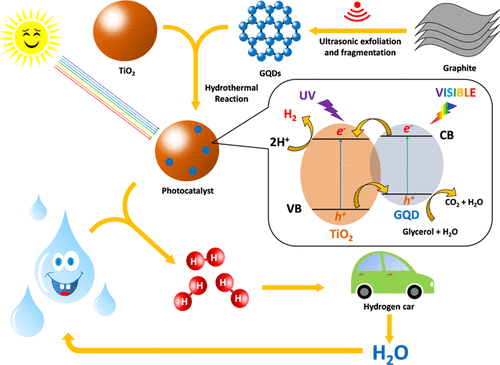当前位置:
X-MOL 学术
›
Ind. Eng. Chem. Res.
›
论文详情
Our official English website, www.x-mol.net, welcomes your feedback! (Note: you will need to create a separate account there.)
Decoration of Graphene Quantum Dots on TiO2 Nanostructures: Photosensitizer and Cocatalyst Role for Enhanced Hydrogen Generation
Industrial & Engineering Chemistry Research ( IF 4.2 ) Pub Date : 2020-06-25 , DOI: 10.1021/acs.iecr.0c01663 Akshaya Raghavan 1, 2 , Suprabhat Sarkar 1, 2 , Lakshmana Reddy Nagappagari 3, 4 , Sreedhar Bojja 2, 5 , Shankar MuthukondaVenkatakrishnan 3 , Sutapa Ghosh 1, 2
Industrial & Engineering Chemistry Research ( IF 4.2 ) Pub Date : 2020-06-25 , DOI: 10.1021/acs.iecr.0c01663 Akshaya Raghavan 1, 2 , Suprabhat Sarkar 1, 2 , Lakshmana Reddy Nagappagari 3, 4 , Sreedhar Bojja 2, 5 , Shankar MuthukondaVenkatakrishnan 3 , Sutapa Ghosh 1, 2
Affiliation

|
Production of H2 fuel from photocatalytic splitting of water is one of the most demanding research studies in terms of sustainable development in the energy sector. In our quest to find an effective photocatalyst for H2 production, we prepared graphene quantum dots/TiO2-based nanocomposites using a simple hydrothermal method and studied the effect of varying morphologies of TiO2 on photocatalytic H2 production. The crystal structure, morphology, surface, and optical properties were thoroughly studied by using X-ray diffraction and different spectroscopic and electron microscopic techniques. The outcome of the comparative study by using various graphene quantum dots/TiO2 nanocomposites found that P-25 TiO2-based nanocomposite gives the highest rate of H2 production among all with 29,548 μmol g–1 h–1 and is almost 14 times efficient compared to pristine P-25 TiO2. It was also evident from the characterization results that the morphology and biphasic nature of TiO2 play a crucial role in H2 production. The plausible reaction mechanism explained the dual role (cocatalyst and sensitizer) of graphene quantum dots on TiO2 nanoparticles and beneficial properties of biphasic TiO2 as an efficient charge transfer mechanism. The prepared photocatalysts also exhibited good stability, which was examined for four cycles with a time period of 4 h, making them feasible candidates for practical applications in the future.
中文翻译:

TiO 2纳米结构上的石墨烯量子点装饰:光敏剂和助催化剂对增强氢气产生的作用
就能源领域的可持续发展而言,光催化分解水生产H 2燃料是最苛刻的研究之一。为了寻找有效的H 2生产光催化剂,我们使用简单的水热法制备了石墨烯量子点/ TiO 2基纳米复合材料,并研究了TiO 2的不同形态对光催化H 2生产的影响。通过使用X射线衍射以及不同的光谱学和电子显微镜技术,对晶体的结构,形态,表面和光学性质进行了彻底的研究。使用各种石墨烯量子点/ TiO 2进行比较研究的结果纳米复合材料发现,基于P-25 TiO 2的纳米复合材料产生的H 2生成率最高,为29,548μmolg –1 h –1,与原始的P-25 TiO 2相比,效率几乎高出14倍。从表征结果还可以看出,TiO 2的形态和双相性质在H 2的产生中起着至关重要的作用。合理的反应机理解释了石墨烯量子点在TiO 2纳米颗粒上的双重作用(助催化剂和敏化剂)以及双相TiO 2的有益性能。作为有效的电荷转移机制。所制备的光催化剂还显示出良好的稳定性,在四个周期的四个小时内对其进行了检查,使其成为未来实际应用的可行候选者。
更新日期:2020-07-22
中文翻译:

TiO 2纳米结构上的石墨烯量子点装饰:光敏剂和助催化剂对增强氢气产生的作用
就能源领域的可持续发展而言,光催化分解水生产H 2燃料是最苛刻的研究之一。为了寻找有效的H 2生产光催化剂,我们使用简单的水热法制备了石墨烯量子点/ TiO 2基纳米复合材料,并研究了TiO 2的不同形态对光催化H 2生产的影响。通过使用X射线衍射以及不同的光谱学和电子显微镜技术,对晶体的结构,形态,表面和光学性质进行了彻底的研究。使用各种石墨烯量子点/ TiO 2进行比较研究的结果纳米复合材料发现,基于P-25 TiO 2的纳米复合材料产生的H 2生成率最高,为29,548μmolg –1 h –1,与原始的P-25 TiO 2相比,效率几乎高出14倍。从表征结果还可以看出,TiO 2的形态和双相性质在H 2的产生中起着至关重要的作用。合理的反应机理解释了石墨烯量子点在TiO 2纳米颗粒上的双重作用(助催化剂和敏化剂)以及双相TiO 2的有益性能。作为有效的电荷转移机制。所制备的光催化剂还显示出良好的稳定性,在四个周期的四个小时内对其进行了检查,使其成为未来实际应用的可行候选者。

























 京公网安备 11010802027423号
京公网安备 11010802027423号